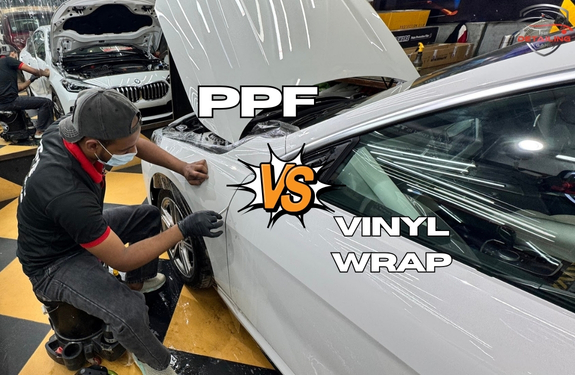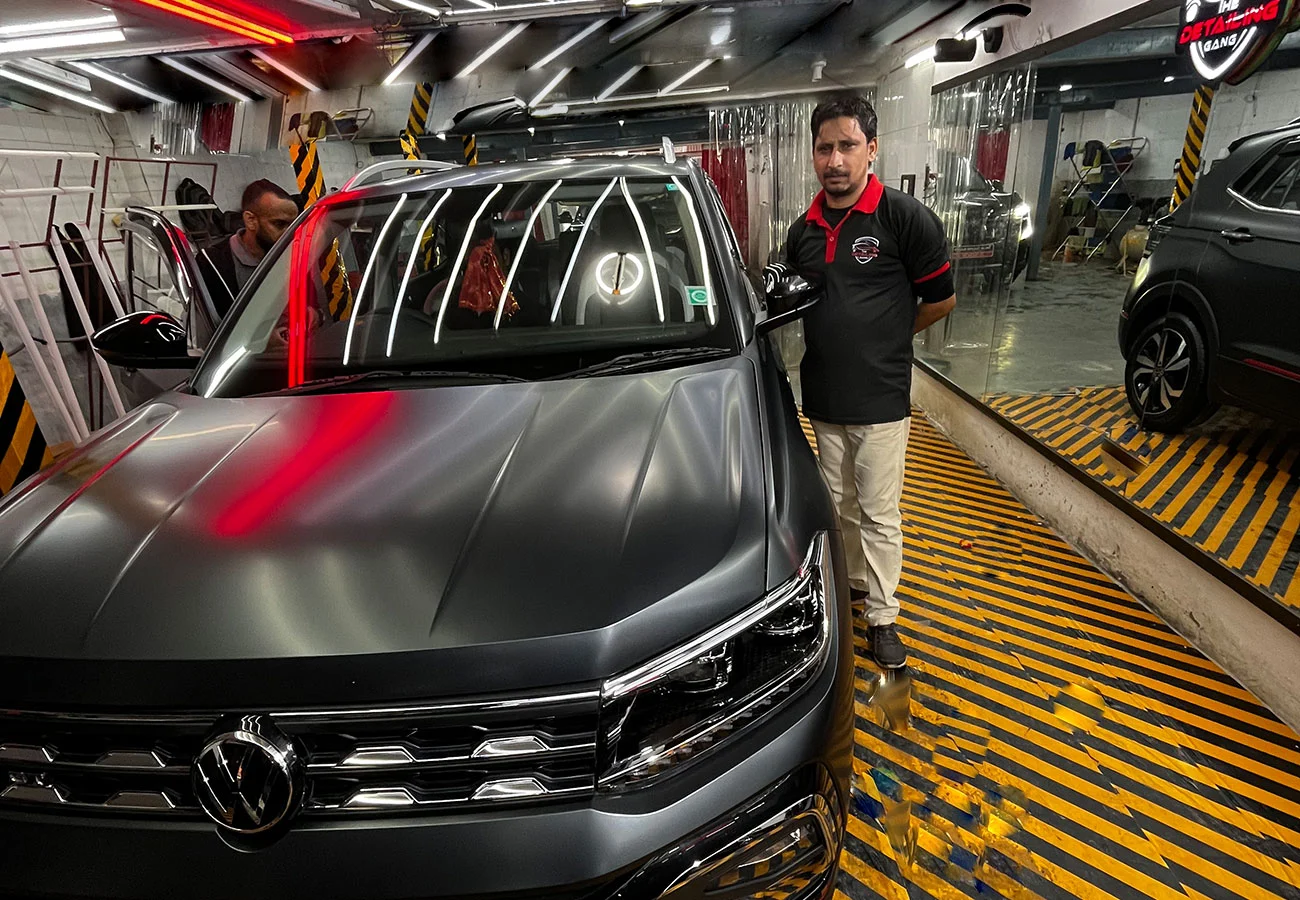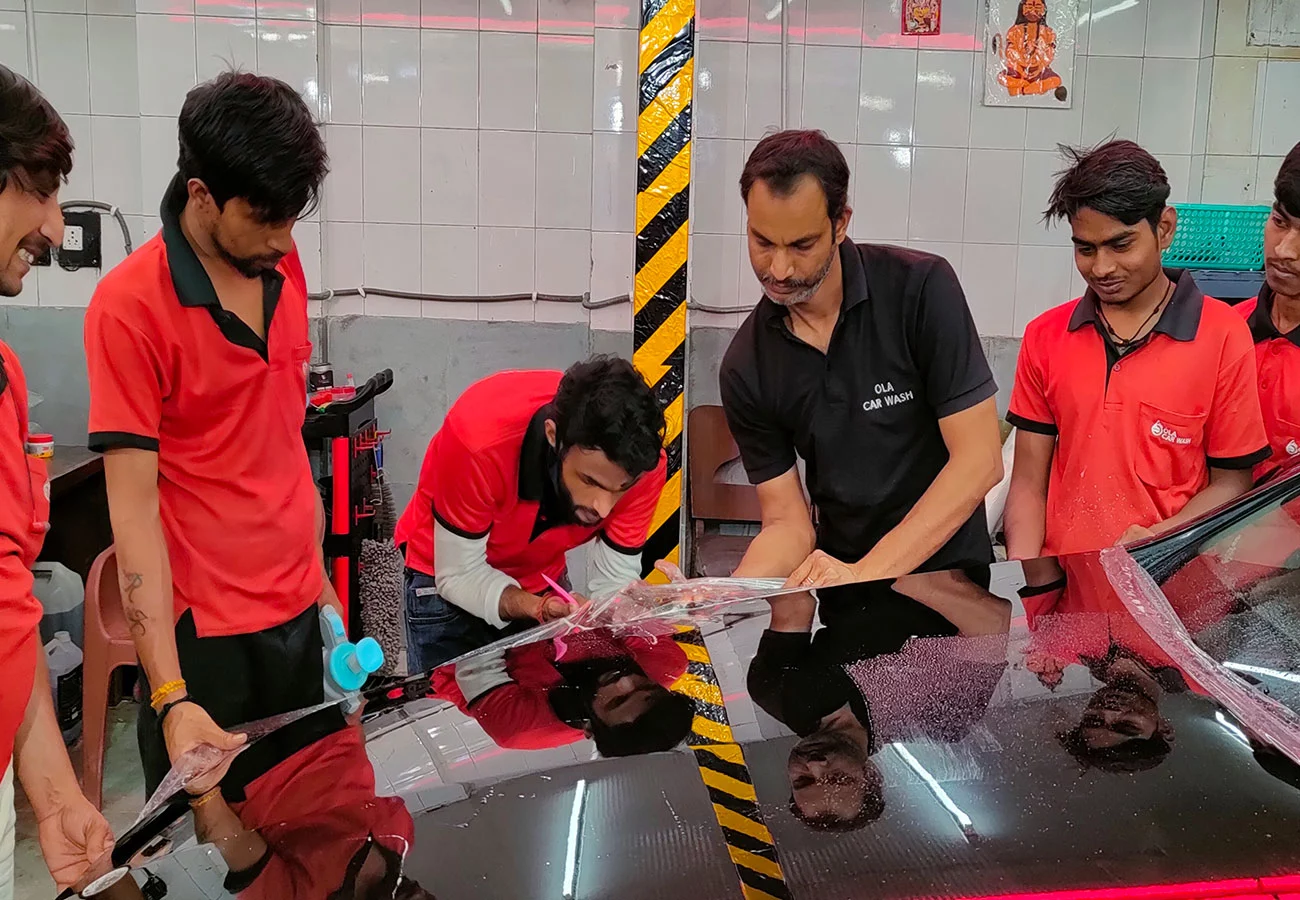
Difference between PPF and Vinyl Wrap: Which is Better?
✏ A Nath | 📅 28 Feb 2024 | 🔖 Car Detailing
There are many choices for customizing and safeguarding your vehicle. Our Detailing Studio focuses on Paint Protection Film and Vinyl Wraps. We frequently get asked which wrap is superior and how they differ. This blog post will address the question of whether PPF or Vinyl Wrap is better, to assist you in selecting the right film for your requirements.
To start the comparison between the two, lets first explain what PPF and Vinyl Wraps are.
What is Paint Protection Film (PPF):
PPF, short for Paint Protection Film, is a thin, transparent layer made of self-healing urethane. It is applied to your vehicles surface to shield it from damage. With a thickness of around 8 mil, it provides excellent protection against scuffs, scratches, and rock chips. Not only does it safeguard your cars paint from physical impacts, but it also shields it from environmental hazards like oil spills, bird droppings, and water marks. Moreover, it acts as a barrier against harmful UV rays, preventing the paint from fading over time.
What is Vinyl Wrap:
Vinyl wrap is a flexible material made of PVC. It is thin, measuring around 3-4 mil in thickness. It is available in various colors, finishes, and textures. The back of the vinyl wrap film has a specially formulated adhesive that allows it to stick securely to surfaces and conform to their shape. Vinyl wrap is commonly used to change the appearance of cars. With a wide range of colors and finishes available, the possibilities are endless. It can also be used to accent specific parts of a car. One popular option is a chrome delete, where all the chrome surfaces of the vehicle are wrapped in vinyl, typically black, although other options are available.
Now that we have provided you with a brief overview of each films purpose, lets proceed to the actual comparison.

PPF or Vinyl Wrap Purpose:
As previously stated, PPF and Vinyl Wraps have distinct purposes. PPF is primarily used to safeguard the vehicles paint from harm. PPF films are transparent and do not alter the vehicles appearance significantly. While it may add a slight shine, there wont be any noticeable differences in how it looks. Due to its protective nature, PPF is thicker than vinyl to effectively shield the paint from impacts.
Vinyl wraps can completely change the appearance of your car. The possibilities for transformations using vinyl wraps are amazing. You can switch from white to black, include unique details, hide chrome parts, or incorporate personalized designs. Vinyl wraps are made specifically to customize the look of your vehicle, which is why the material is thinner than PPF and has a bit more flexibility.
Surface Protection:
Paint Protection Films remains the top choice for safeguarding your car against external harm. However, Vinyl Wrap can also offer a slight level of protection. Although not as thick, it acts as a shield for your cars paint, providing a slight barrier. While it may not fully guard against deep scratches or scuffs, it does shield against minor rock chips, bird droppings, and the harmful impact of UV light.
PPF is the best choice if you need thorough protection. It works well for off-road or highway driving. However, if you mainly drive in the city, vinyl wraps can also offer some level of protection.
Thickness:
When it comes to measuring thickness in the automotive wraps and films industry, the unit used is called a "mil". This term is derived from the French word "mille" which means "one thousand", because 1mil = 1 thousandth of an inch. To give you an example, a credit card has a thickness of approximately 30mil, while a piece of photo paper from a 1-hour photo developer is about 8.5mil. As for a piece of newspaper, its thickness ranges from 2.5 to 3.5mil.
People want their PPF to be resistant to impact and scratches, so it is usually thicker than vinyl wraps. The thickness of PPF can vary depending on the model and manufacturer, ranging from 6mil to 10mil. On the other hand, Vinyl wraps are much thinner than PPF. This is because of the different materials, and to save weight.
Also Check - Best Paint Protection Film in India. Top Brands and Updated Price: 2025.
Longevity:
PPF and Vinyl Wrap Films can both last for a considerable amount of time if installed correctly. Generally, PPF tends to have a longer lifespan compared to Vinyl wrap.
With proper care, you can expect a well-maintained PPF car to have a lifespan of 5 to 12 years. On the other hand, vinyl wraps, if cared for properly, will last for about 5 years.

Customization:
PPF allows you to decide where to put the film, but visually they all look the same - transparent. Various films are used to protect the shiny or matte surfaces of a vehicles paint.
Read More :
Vinyl wraps offer endless possibilities for your creativity with their wide color options. In most cases, they cover the entire vehicle, but they dont have to be one solid color. With vinyl wraps, you can have custom designs, logos, and any finish you can imagine.
Price:
Installing PPF usually costs more than vinyl wrap. The price of PPF on a car starts at Rs. 45,000 and goes up to Rs. 1,50,000 and beyond, depending on the car size, detailer reputation, and PPF brand you select. On the other hand, the price for wrapping a car starts at Rs. 30,000 to Rs. 45,000+. To know the exact best price for your vehicle in Delhi, simply call our experts at +91-7311108111 (9am to 7pm) or ![]() anytime. Check out our range of the best paint protection film services now.
anytime. Check out our range of the best paint protection film services now.
Get a 100% satisfaction guarantee with "The Detailing Gang", co-powered by Ola Car Wash Pvt. Ltd.
Our Workshop location: X-14, Ground Floor, Okhla Phase II, South Delhi, New Delhi-110020 (IN) 📌
Conclusion: PPF or Vinyl Wrap?
There is no definitive answer on which film is better. Both have their strengths and serve different purposes.
If you want to change your vehicles appearance and provide some protection while driving in the city, Vinyl Wrap is a good option. It offers a level of protection and can help you save money.
On the other hand, if you need full protection against various road hazards and have the budget for it, PPF is the way to go. Applying PPF right after getting your car from the dealership will help maintain the original paint condition for years.
FAQ: PPF vs Vinyl Wrap.
Q1. What is the main difference between vinyl wrap and PPF?
Ans. The role they have in protecting vehicles is important. The paint protection film is thicker and provides a stronger shield against road debris, rock chips, and environmental hazards. On the other hand, vinyl wrap only offers partial protection against scratches and minor damage and is better suited for customizing the appearance of a car.
Q2. Which is more durable: paint protection film or vinyl wrap?
Ans. TPU (PPF) has a higher melting point than PVC (Vinyl), making PPF more flexible and less likely to crack. When bent, the vinyl wrap has more chances to break or distort.
Q3. Do PPF and vinyl wrap have a similar look?
These are completely different. PPF is a transparent film that maintains the original appearance of your vehicle. Vinyl wrap offers various colors and patterns to enhance the visual appeal of your car.
Q4. Which coating lasts longer, PPF or Vinyl Wrap?
Ans. PPF can last up to 12 years with good installation, maintenance, and film quality. On the other hand, vinyl wrap typically lasts between 3 to 5 years.
Q5. Is it easier to install PPF or vinyl wrap?
Ans. It is recommended to seek assistance from a professional to apply a protective coating on your car. PPF should be applied when the car is wet, whereas vinyl wrap is applied on a dry surface.
Q6. Which option is more affordable—PPF or vinyl wrap?
Ans. The final cost depends on various factors such as the size of the area to be covered, the complexity of the design, and the cost of the coating. Generally, vinyl wraps are cheaper than PPF. Despite being more expensive, PPF is a great investment for the long run as it keeps your car looking good and increases its resale value.